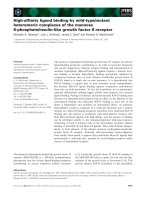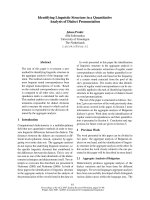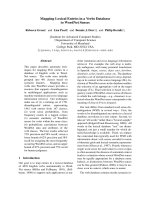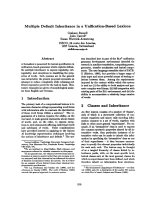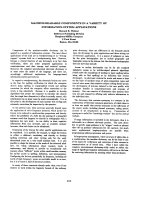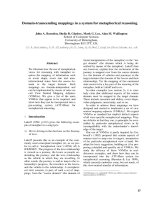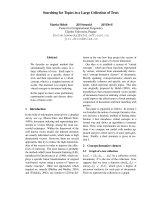Báo cáo khoa hoc:" Papillary carcinoma arising in a thyroglossal duct cyst with associated microcarcinoma of the thyroid and without cervical lymph node metastasis: a case report" pot
Bạn đang xem bản rút gọn của tài liệu. Xem và tải ngay bản đầy đủ của tài liệu tại đây (363.18 KB, 3 trang )
BioMed Central
Page 1 of 3
(page number not for citation purposes)
Journal of Medical Case Reports
Open Access
Case report
Papillary carcinoma arising in a thyroglossal duct cyst with
associated microcarcinoma of the thyroid and without cervical
lymph node metastasis: a case report
Tolga Kandogan*
1
, Nazif Erkan
2
and Enver Vardar
3
Address:
1
Department of Otolaryngology, Izmir Training and Research Hospital, Bozyaka İzmir 35290 Turkey,
2
Department of Surgery, Izmir
Training and Research Hospital, Bozyaka İzmir 35290 Turkey and
3
Department of Pathology, Izmir Training and Research Hospital, Bozyaka İzmir
35290 Turkey
Email: Tolga Kandogan* - ; Nazif Erkan - ; Enver Vardar -
* Corresponding author
Abstract
Introduction: This is a case report of a 44-year-old woman with papillary carcinoma of a
thyroglossal duct cyst.
Case presentation: A 44 year-old woman presented to the otolaryngology outpatient clinic with
an asymptomatic anterior midline neck mass. A cervical ultrasound showed a lesion which appeared
to be a thyroglossal duct cyst and surgical resection using Sistrunk's procedure was performed. The
histopathologic diagnosis showed papillary carcinoma evolving from a thyroglossal duct cyst,
confined to the thyroglossal cyst, with a tumor diameter of 2 cm. The patient then underwent total
thyroidectomy and bilateral neck dissection. The final pathology reported an 8 mm papillary cancer
in the left lobe of the thyroid without any metastasis to the cervical lymph nodes. The patient was
treated with radioactive iodide and thyroid suppresion therapy was given as adjuvant treatment.
The patient has been following for two years without any metastasis.
Conclusion: Malignancy within a thyroglossal duct cyst is very rare but should be considered in
the differential diagnosis of a midline neck mass.
Introduction
As the thyroid gland descends from the foramen cecum to
its location at the point below the thyroid cartilage, it
leaves behind an epithelial trace known as the thyroglos-
sal tract. The tract disappears during the 5th-10th gesta-
tional week. Incomplete atrophy of the thyroglossal tract,
or retained epithelial cysts, creates the basis for the origin
of a thyroglossal duct cyst (TGDC). A thyroglossal rem-
nant can be a cyst, a tract or duct, a fistula, or an ectopic
thyroid within a cyst or duct [1].
A TGDC is the most common anomaly in the develop-
ment of the thyroid gland [2]. 70% are diagnosed in child-
hood and 7% are diagnosed in adulthood [3]. Only 1% of
thyroid carcinomas arise from a TGDC [4].
In this report, we present a female adult with a papillary
carcinoma of the TGDC.
Case presentation
A 44-year-old woman presented to the otolaryngology
outpatient clinic with an asymptomatic anterior midline
Published: 8 February 2008
Journal of Medical Case Reports 2008, 2:42 doi:10.1186/1752-1947-2-42
Received: 26 April 2007
Accepted: 8 February 2008
This article is available from: />© 2008 Kandogan et al; licensee BioMed Central Ltd.
This is an Open Access article distributed under the terms of the Creative Commons Attribution License ( />),
which permits unrestricted use, distribution, and reproduction in any medium, provided the original work is properly cited.
Journal of Medical Case Reports 2008, 2:42 />Page 2 of 3
(page number not for citation purposes)
neck mass. The tumor had developed over 6 months.
Physical examination revealed a 2 × 2 cm mass on the
anterior part of the neck between the thyroid cartilage and
hyoid. She was in good health otherwise and her past
medical history was unremarkable.
A cervical ultrasound showed a lesion which appeared to
be a TGDC and surgical resection by means of Sistrunk's
procedure was performed. The histopathologic diagnosis
was a papillary carcinoma evolving from a TGDC, con-
fined to the thyroglossal cyst with a tumor diameter of 2
cm (Figure 1). The patient was referred to the surgery
department for further investigation. Thyroid scintigra-
phy, ultrasound and cervical CT scans were performed.
The thyroid scintigraphy was normal. The cervical ultra-
sound showed multiple cervical lymph nodes which were
of different sizes ranging from 8 mm to 17 mm. A cervical
CT revealed bilateral cervical lymph nodes less than 2 cm
in diameter. The patient's thyroid function tests were
within normal limits. Total thyroidectomy and bilateral
neck dissection were performed. The final postoperative
pathology reported an 8 mm papillary cancer in the left
lobe of the thyroid without any metastasis to the cervical
lymph nodes (Figure 2). The patient was treated with radi-
oactive iodide and thyroid suppresion therapy was given
as an adjuvant treatment. The patient has been following
without any metastasis for two years.
Discussion
A mass in the neck is a common clinical finding and dif-
ferential diagnosis may be extremely broad. Although
most masses are due to benign processes, malignant dis-
eases must not be overlooked. Therefore, it is important to
develop a systematic approach for the diagnosis and man-
agement of neck masses.
Benign thyroglossal duct cysts usually present as aysmpto-
matic, soft, firm, or hard masses in the midline of the
anterior neck, and are nontender and generally movable.
Malignant thyroglossal duct cysts present in the same
manner. Carcinoma should be suspected in any thy-
roglossal duct cyst that is hard, fixed and irregular or
which has undergone recent change. A history of irradia-
tion of the head and neck or mediastinum during child-
hood or adolescence sholud also arouse suspicion of
carcinoma [1].
Malignant tumors developing from the thyroglossal duct
have two origins: thyrogenic carcinoma arising from thy-
roembrionic remnants in the duct or a cyst, and squamous
cell carcinoma arising from metaplastic columnar cells
that line the duct [1]. More then 200 cases of thyroglossal
duct carcinomas have been reported in which papillary
carcinoma accounts for 80% of cases, with the rest being
squamous cell carcinoma [5-7]. Only one case with both
concomitant histologic findings has been reported [8].
Excluding medullary carcinoma, which arises from para-
follicular cells embryologically unrelated to the thyroid,
all forms of primary thyroid carcinoma can arise in the
thyroglossal duct [1].
The main difficulty encountered with a cancer evolving
from a thyroglossal duct cyst is that the diagnosis is usu-
ally made during surgery or from definitive pathological
samples. Because the frequency of cancer of the thyroglos-
sal duct cyst is very low, the clinician often does not con-
sider an oncologic diagnosis. A second difficulty lies in
Papillary cancer in the left lobe of the thyroidFigure 2
Papillary cancer in the left lobe of the thyroid. (H&E).
Papillary carcinoma evolving from a TGDC, confined to the thyroglossal cystFigure 1
Papillary carcinoma evolving from a TGDC, confined to the
thyroglossal cyst. (H&E).
Publish with BioMed Central and every
scientist can read your work free of charge
"BioMed Central will be the most significant development for
disseminating the results of biomedical research in our lifetime."
Sir Paul Nurse, Cancer Research UK
Your research papers will be:
available free of charge to the entire biomedical community
peer reviewed and published immediately upon acceptance
cited in PubMed and archived on PubMed Central
yours — you keep the copyright
Submit your manuscript here:
/>BioMedcentral
Journal of Medical Case Reports 2008, 2:42 />Page 3 of 3
(page number not for citation purposes)
terms of what approach should be taken during and after
surgery when dealing with a preoperatively diagnosed thy-
roglossal cyst; that is, how extensive should the surgery be
and what type of adjuvant therapy should be used [9]? To
be able to respond to these two issues, the procedure used
for thyroglossal cyst surgery must be standarized.
When a thyroglossal duct cyst has been excised using Sis-
trunk's procedure and when the definitive hystological
analysis reports malignancy, the thyroid gland must be
studied with radiological and scintigraphic examinations
and the extension of surgery must be handled according
to the criteria established for differentiated thyroid cancer
[9]. In our case, we made a radical surgical method with
total tyroidectomy and bilateral neck dissection due to
findings on cervical CT.
The common surgical procedure used for a thyroglossal
duct cyst is Sistrunk's procedure, consisting of excision of
the thyroglossal duct cyst, the central portion of the body
of the hyoid bone, and a core of tissue around the thy-
roglossal tract to open into the oral cavity at the foramen
cecum[1]. In case of malignancy, additional steps should
consist of thyroidectomy, radioactive iodine and thyroid
supression, as is the case for differentiated thyroid cancers.
Conclusion
Malignancy within a thyroglossal duct cyst is very rare but
should be included in the differential diagnosis of a neck
mass. This condition is rarely diagnosed preoperatively.
Once diagnosed, therapy includes surgery, radioactive
iodine and thyroid supression, as is the case for differenti-
ated thyroid cancers.
Competing interests
The author(s) declare that they have no competing inter-
ests.
Authors' contributions
TK, NE and EV drafted the manuscript and designed the
case report. All authors read and approved the final man-
uscript.
Consent
Written informed patient consent was obtained for publi-
cation.
References
1. Peretz A, Leiberman E, Kapelushnik J, Hershkovitz E: Thyroglossal
duct carcinoma in children: Case presentation and review of
the literature. Thyroid 2004, 14:777-785.
2. Vera-Sempere F, Tur J, Perolada JM, Morera C: Papillary thyroid
cacinoma arising in the wall of a thyroglossal duct cyst. Acta
Otorhinolaryngol Belg 1998, 52:49-54.
3. Yang YJ, Wanamaker JR, Powers CN: Diagnosis of papillary carci-
noma in a thyroglossal duct cyst by fine needle aspiration
biopsy. Arch Pathol Lab Med 2000, 124:139-142.
4. Dedivitis RA, Guimareas AV: Papillary thyroid carcinoma in thy-
roglossal duct cyst. Int Surg 2000, 85:109-201.
5. Weiss SD, Orlich CC: Primary papillary carcinoma of a thy-
roglossal duct cyst: Report of a case and literature review. Br
J Surg 1991, 78:87-89.
6. Chu YC, Han JY, Han HS, Kim JM, Min SK, Kim YM: Primary papil-
lary carcinoma arising in a thyroglossal duct cyst. Yonsei Med
J 2002, 43:381-384.
7. Hesmati HM, Fatourechi V, van Heerden JA, Hay ID, Goellner JR:
hyroglossal duct carcinoma: Report of 12 cases. Mayo Clin Proc
1997, 72:T315-319.
8. Kwan WB, Liu FF, Banerjee D, Rotstein LE, Tsang RW: Concurrent
papillary and squamous carcinoma in a thyroglossal duct
cyst: A case report. Can J Surg 1996, 39:328-332.
9. Luna Ortiz K, Hurtado-Lopez LM, Valderrama-Landaeta JL, Ruiz-Vega
A: Thyroglossal duct cyst with papillary carcinoma: What
must be done? Thyroid 2004, 14:363-366.
